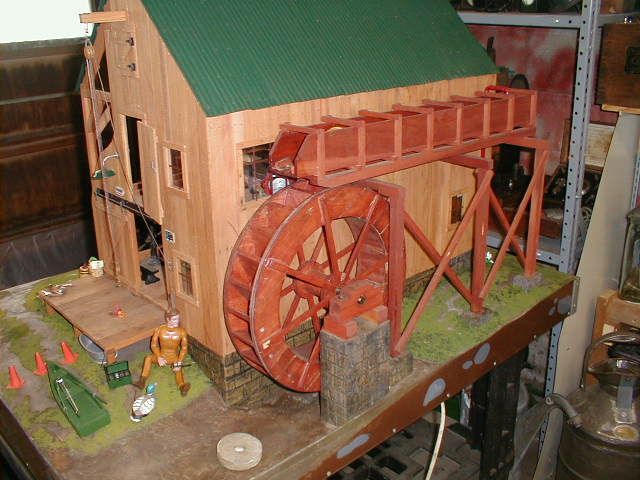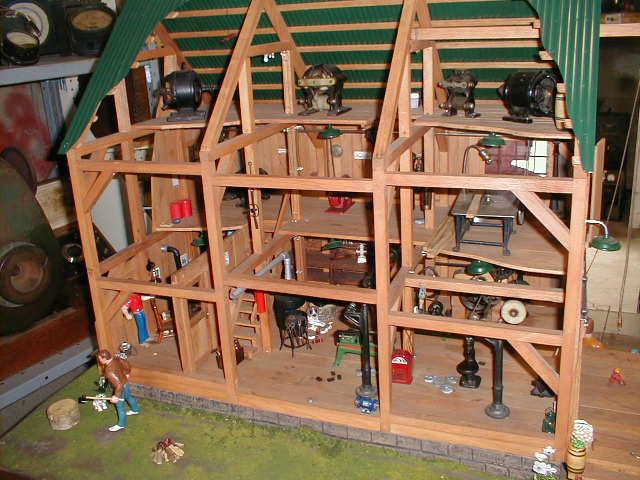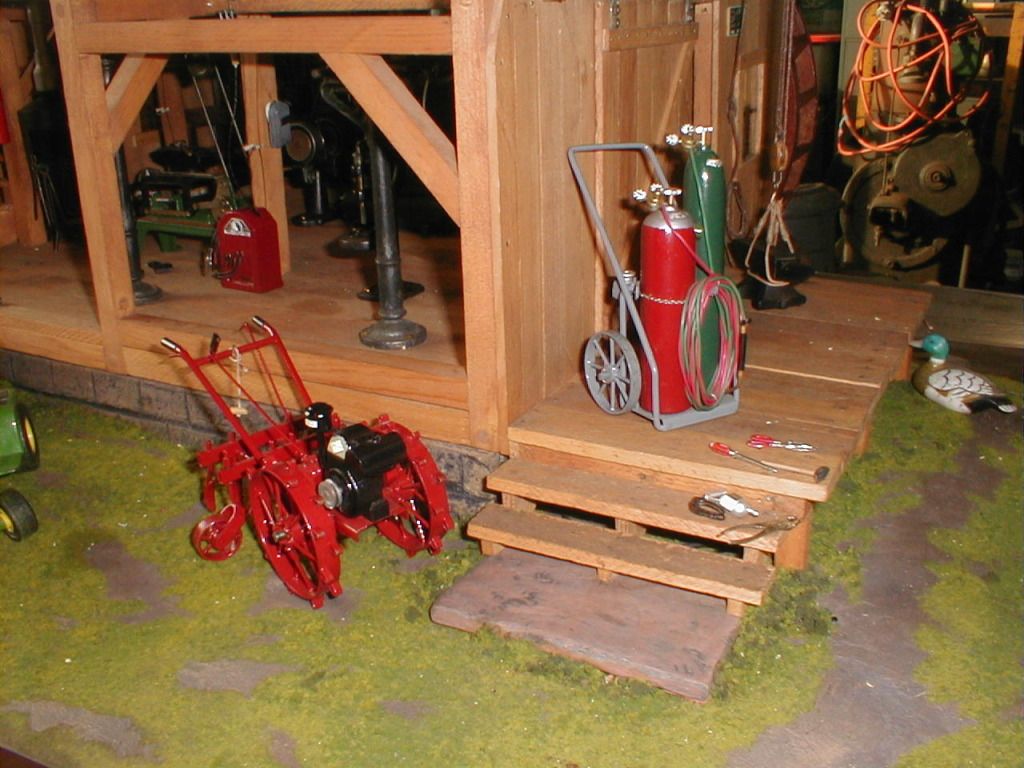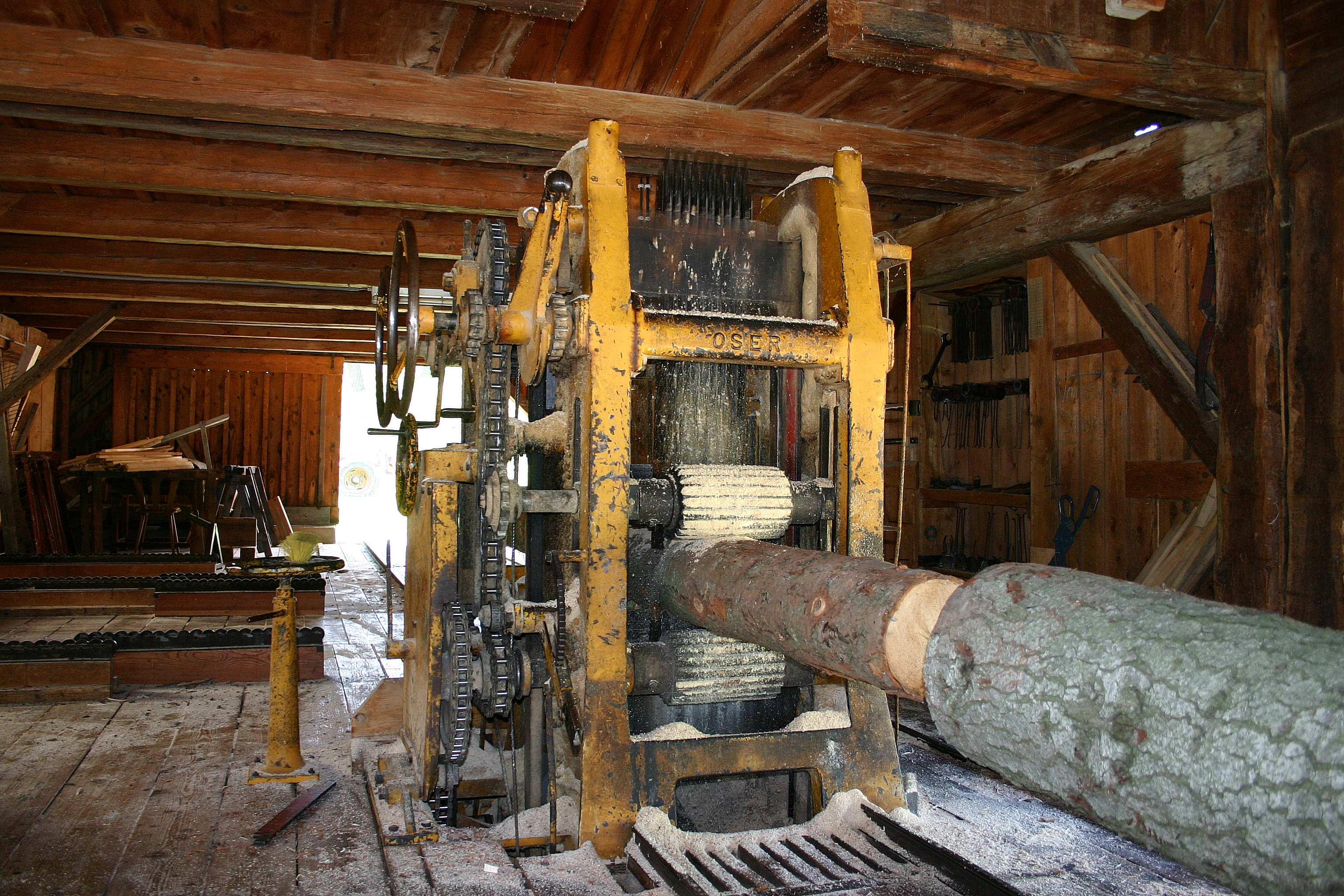Now that I have finished the Atkinson engine, its time to start thinking about another machining project. I don't think I want to build another engine of any type, as I am somewhat over-ran with engines now. I have 10 different steam engines and 3 internal combustion engines. The steam engines, which I run off my air compressor are fun to look at, but rather gutless in terms of power when compared to the i.c. engines. My favourite i.c. engine is the Kerzel hit and miss that I built a couple of years ago. Even it would probably not have sufficient power to run a circular saw blade, but I am thinking in terms of the old mills which were water powered and had a vertical blade that moved up and down like a jig-saw. These sawmills didn't require a lot of power to drive them. The log wasn't fed into the saw by a cable driven carriage, but there was a ratchet and paul device that would move the log into the sawblade during the downstroke (which was the cutting stroke) and "pause" the log during the sawblades upstroke so as not to put pressure on the blade when it was lifting. I have to do some more research on this, but it might make an interesting project. A fine toothed sabre saw blade would probably be close to the right size, and the "logs" to be sawed would be peices of 1" diameter wooden dowel.----Brian
You are using an out of date browser. It may not display this or other websites correctly.
You should upgrade or use an alternative browser.
You should upgrade or use an alternative browser.
Model Sawmill Dreaming---
- Thread starter Brian Rupnow
- Start date

Help Support Home Model Engine Machinist Forum:
This site may earn a commission from merchant affiliate
links, including eBay, Amazon, and others.
Beachside_Hank
Well-Known Member
- Joined
- Oct 26, 2012
- Messages
- 71
- Reaction score
- 27
I observed a vertical blade sawmill at Old Sturbridge Village in Massachusetts that was water wheel powered, the stroke speed and feed were unbelievably fast. You’d think being water powered it’s take long, slow, labored licks, but it was just as fast as an electrical powered head mill. There was no upstroke compensation mechanism, just a simple method whereby the blade, instead of being pure vertical as it enters the cut, was pitched forward a few degrees so that on the return upstroke it effectively moved away from the work just enough to disengage tooth contact. Simple and brilliant I thought.


Sounds an interesting project Brian.
I wonder if a sabre saw blade may be a bit thick and the amount of wood removed would put more load on the machine due to the wide kerf. Maybe a section of bandsaw blade particularly if you can get the narrow meat & fish type blades which are only 0.020-0.025".
J
I wonder if a sabre saw blade may be a bit thick and the amount of wood removed would put more load on the machine due to the wide kerf. Maybe a section of bandsaw blade particularly if you can get the narrow meat & fish type blades which are only 0.020-0.025".
J
Generatorgus
Senior Member
- Joined
- Feb 25, 2010
- Messages
- 362
- Reaction score
- 167
Hi Brian, I have some experience on this subject.
Quite a few years ago I got a whim to power a small Wilesco (I think) generator with a water wheel.
I decided to build a 2 story 1/12th scale model of a mill and put the generator in it, running a light or two.
My dream was somewhat dampened when I got it all done and the 16" wheel didn't have enough output to run the genny, it would hardly turn it.
I'm not sure how big a wheel I would have needed to run it. Sawing even a small tiny piece of wood would not be possible with my set up.
Happy ending is I decided to scrap the generator thing and run some other toy stuff. I installed antique toy line shaft setups and built a lot of model stuff to outfit it.
I've took the mill to Cabin Fever a few years back and it drew a lot of attention.
Not trying to steal your post, just wanting to give you a heads up on the power issue, I guess physics has a lot to do with it.
Just can't resist showing it off a little.



Quite a few years ago I got a whim to power a small Wilesco (I think) generator with a water wheel.
I decided to build a 2 story 1/12th scale model of a mill and put the generator in it, running a light or two.
My dream was somewhat dampened when I got it all done and the 16" wheel didn't have enough output to run the genny, it would hardly turn it.
I'm not sure how big a wheel I would have needed to run it. Sawing even a small tiny piece of wood would not be possible with my set up.
Happy ending is I decided to scrap the generator thing and run some other toy stuff. I installed antique toy line shaft setups and built a lot of model stuff to outfit it.
I've took the mill to Cabin Fever a few years back and it drew a lot of attention.
Not trying to steal your post, just wanting to give you a heads up on the power issue, I guess physics has a lot to do with it.
Just can't resist showing it off a little.



Great models GeneratorGus---However, as I said in my first post, I will be using an internal combustion engine for power.----Brian

$55.69
Amana Tool - 46280 CNC 2D & 3D Carving 6.2 Deg Tapered Angle Ball Tip x 1/32 Dia x 1/64
Routerbitworld

$15.99 ($0.05 / Count)
$18.99 ($0.06 / Count)
HongWay 300pcs 2 Inches Sanding Discs Pad Kit for Drill Sanding Grinder Rotary Tools with Backer Plate Shank and Soft Foam Buffering Pad, Sandpapers Includes 60-3000 Grit
HongWay US

$39.99
$49.99
Sunnytech Low Temperature Stirling Engine Motor Steam Heat Education Model Toy Kit For mechanical skills (LT001)
stirlingtechonline

$190.00
$254.99
Genmitsu CNC 3018-PRO Router Kit GRBL Control 3 Axis Plastic Acrylic PCB PVC Wood Carving Milling Engraving Machine, XYZ Working Area 300x180x45mm
SainSmart Official

$104.99
Sunnytech Hot Air Stirling Engine Motor Steam Heat Education Model Toy Kit M16-CF
stirlingtechonline

$59.99
Sunnytech Hot Air Stirling Engine Motor Model Educational Toy Electricity Generator Colorful LED (SC001)
stirlingtechonline

$649.00
$699.00
FoxAlien Masuter Pro CNC Router Machine, Upgraded 3-Axis Engraving All-Metal Milling Machine for Wood Acrylic MDF Nylon Carving Cutting
FoxAlien Official

$45.99
Sunnytech Mini Hot Air Stirling Engine Motor Model Educational Toy Kits Electricity HA001
stirlingtechonline
Brian have you thought of a drag saw, that would be more in keeping with a small hit & miss engine
[ame]http://youtu.be/7XtxBUqJ3Xw[/ame]
I've just got castings for a 1/3 scale Galloway and may make a cross cut saw rig for that bit it will have a bit more power than your smaller engines.
J
[ame]http://youtu.be/7XtxBUqJ3Xw[/ame]
I've just got castings for a 1/3 scale Galloway and may make a cross cut saw rig for that bit it will have a bit more power than your smaller engines.
J
Jason--Thats very interesting. I had never seen a drag saw before. I don't think thats the type I would build, but its an interesting video.
Last edited:
Thinking about this some more. It will be no problem to run the sawblade up and down. All that requires is an offset, a connecting rod, and a pair of guides to make the blade run true. However, advancing the log intermitantly will be a challenge. Obviously the log will have to be secured to a carriage, which will run on a pair of inverted V tracks to guide it. Now on a circular blade sawmill, there is a winch drum which winds an endless cable to pull the carriage and log thru the saw in one continuous movement. Then the winch drum is reversed to return the carriage to the other end and the log is "dogged over" for another pass thru the circular saw. On the type I am proposing, the carriage will only advance while the saw blade is being pulled down thru the cut, but must stop while the sawblade is pushed back up to the top. This intermittant advancing of the carriage is accomplished by a ratchet and paul mechanism that is geared to the movement of the sawblade.The amount of carriage advance with each downstroke of the blade will be very small, probably only .030" or so. Since it is geared to the sawblade mechanism, if the saw speeds up, the carriage advancement speeds up with it, but still only advances the same distance with each downstroke. ----Brian
Here is a great video showing the ratchet and paul device which moves the mill carriage along!!! It doesn't show it clearly, but it appears that the bottom of the carriage has a long gear rack attached to it, and the very large ratchet wheel turns a shaft with a small pinion on it that engages the rack and moves the carriage foreward. I have no idea of how they backed the carriage up to saw another board, but it MAY have been done manually.
[ame]http://www.youtube.com/watch?v=wQVv-DInqSY[/ame]
[ame]http://www.youtube.com/watch?v=wQVv-DInqSY[/ame]
Last edited:
kutzdibutz
Well-Known Member
- Joined
- Feb 16, 2012
- Messages
- 74
- Reaction score
- 28
Hi Brian,
Hmm- why not go for this design? This slices multiple boards in one go...
The feed is done with this nasty shaped rolls, but a ratchet drive would make completely sense I think. I saw a model of this type at a fare but didnt take any photos. But it looked sweet anyhow.

Good luck with your project and the selection!
Cheers, Karsten
Hmm- why not go for this design? This slices multiple boards in one go...
The feed is done with this nasty shaped rolls, but a ratchet drive would make completely sense I think. I saw a model of this type at a fare but didnt take any photos. But it looked sweet anyhow.

Good luck with your project and the selection!
Cheers, Karsten
Kutzdibutz---I worked for a few years designing high production sawmill equipment for use in Ontario, Canada. The machine you show was called a "Bull Edger" and by adjusting the spacers between the saw blades you could get it to produce many different thicknesses of boards.
Here is another video---The first half is still shots, then it shows a schematic plan of the overall mechanism, then it goes into actual video mode----And right at the end it shows the carriage advance mechanism working.
http://www.youtube.com/watch?feature=player_detailpage&v=fG6L2sx_-fk
http://www.youtube.com/watch?feature=player_detailpage&v=fG6L2sx_-fk
- Joined
- Jul 16, 2007
- Messages
- 3,027
- Reaction score
- 1,118
Hi Brian,
I too am not trying to hijack your thread but want to let you know my experience with sawing wood with a miniature engine. I have a 1" scale Case steam traction engine and have several accessories for it not the least of which is a 1" Russell sawmill. I know it's a circular saw type but I think you will run into the same problems I have. First off it takes much more power to drag a saw blade through wood than you can imagine. Even with your proposed type the blade will have loading on each tooth and this equates to a heck of a lot of drag. Probably the only way you could accomplish this is to gear the engine way down so you have as much torque at the blade as possible.
With my sawmill I ended up powering it with a 2 cylinder steam engine with a bore and stroke of .750. It's double acting and when running at about 1500 rpm it will go through a slab of .375 Cedar fairly well. I once tried a small dried out branch from a tree but I couldn't slow my infeed down enough and it would stall the blade. It seems like the power from little engines is reduced by the square or cube root or something.
Anyway here's a couple of shots of my 1" Russell saw mill.
gbritnell


I too am not trying to hijack your thread but want to let you know my experience with sawing wood with a miniature engine. I have a 1" scale Case steam traction engine and have several accessories for it not the least of which is a 1" Russell sawmill. I know it's a circular saw type but I think you will run into the same problems I have. First off it takes much more power to drag a saw blade through wood than you can imagine. Even with your proposed type the blade will have loading on each tooth and this equates to a heck of a lot of drag. Probably the only way you could accomplish this is to gear the engine way down so you have as much torque at the blade as possible.
With my sawmill I ended up powering it with a 2 cylinder steam engine with a bore and stroke of .750. It's double acting and when running at about 1500 rpm it will go through a slab of .375 Cedar fairly well. I once tried a small dried out branch from a tree but I couldn't slow my infeed down enough and it would stall the blade. It seems like the power from little engines is reduced by the square or cube root or something.
Anyway here's a couple of shots of my 1" Russell saw mill.
gbritnell


mygrizzly1022
Member
- Joined
- Sep 4, 2010
- Messages
- 75
- Reaction score
- 7
Hi Brian
I don’t know if you havecome across this document or not. It may be of some help.
Regards ….bert
http://www.mcmillanlibrary.org/rosholt/wi-logging-book/wilogging/images/00000031.pdf
GBritnell---What a superb peice of engineering!!! Simply beautifull. f350ca---I know parts of the Madawaska. I grew up in Bancroft. In fact, when I went to high school there, the schoolbus brought boys and girls down from the village of Madawaska to high school in Bancroft. I had a good friend, Bob Lavalee from Madawaska, who lost a leg in a snowmobile accident when he was a young man. mygrizzly1022---Thanks for the information.--Lots of good reading there.----Brian
Brian,
I'm further down stream in Calabogie, grandpa's mill was at Camel Chute, now under water after they built the Mountain Chute dam. All these places were so named for the log chute there that diverted the logs around rapids or falls.
Would be a drive but apparently Upper Canada Village has an operating stroke saw.
Greg
I'm further down stream in Calabogie, grandpa's mill was at Camel Chute, now under water after they built the Mountain Chute dam. All these places were so named for the log chute there that diverted the logs around rapids or falls.
Would be a drive but apparently Upper Canada Village has an operating stroke saw.
Greg
f350ca---There is a mill like that at OHaras Mill just north of Madoc. I have seen it operating.
From what I can tell, the saw and reciprocating mechanism would be a peice of cake.---Very straightforeward. The more problematic side of what I have in mind would be the carriage advance mechanism. I do have a set of 24DP gearcutters, so I could probably machine a gear large enough to act as the ratchet wheel. Might be a problem though, finding a "model size" rack and pinion for the carriage. If I sawed 6" long x 1" diameter "logs" then I would need a rack about 8" long, with a #24 pitch. I MIGHT be able to machine one.
Similar threads
- Replies
- 61
- Views
- 12K



































